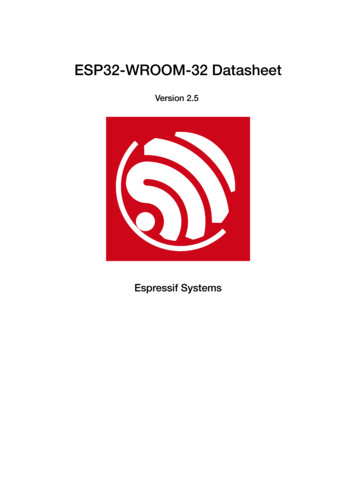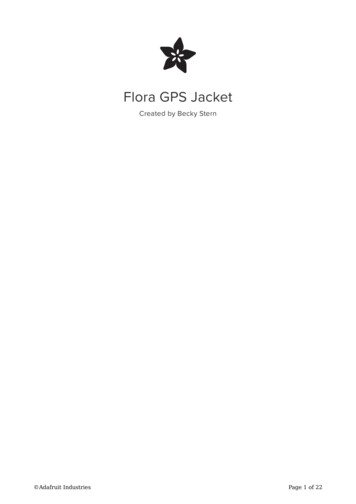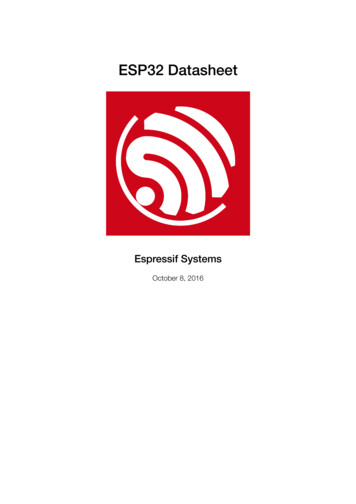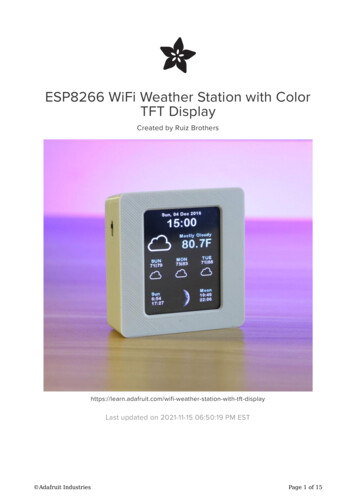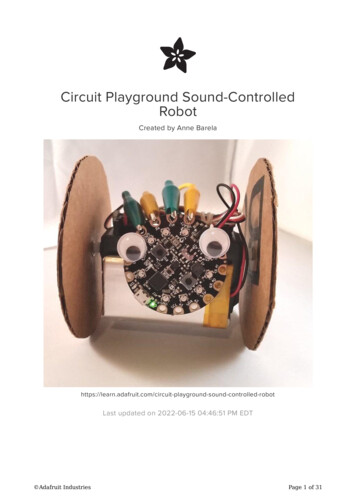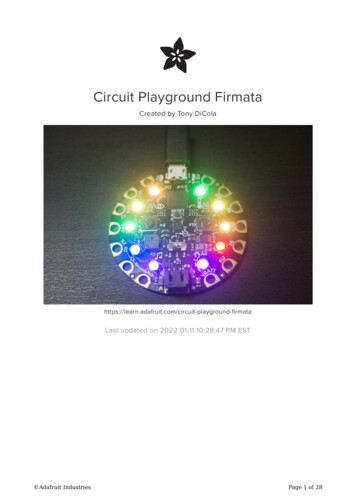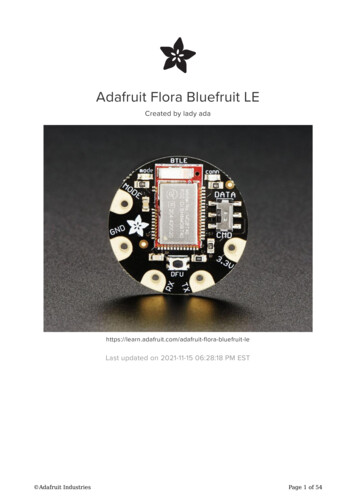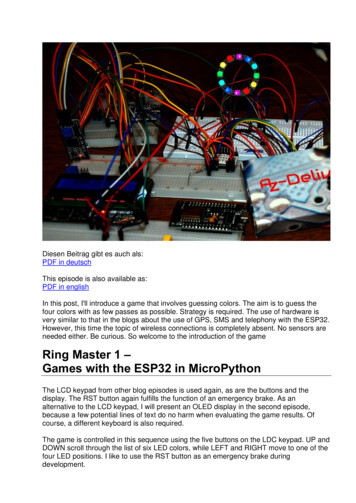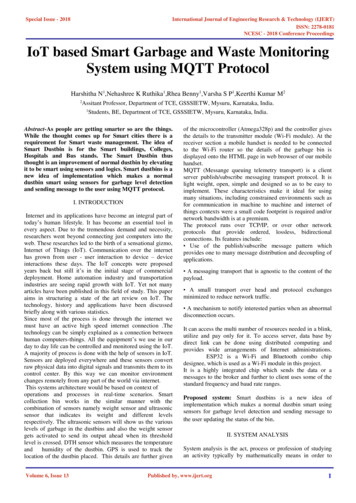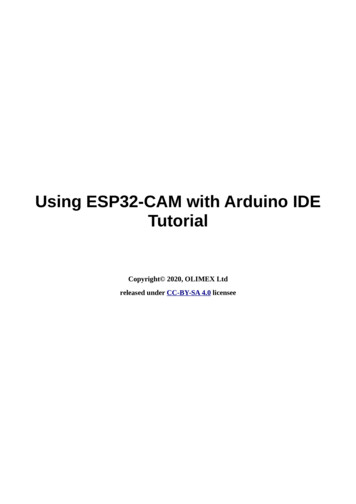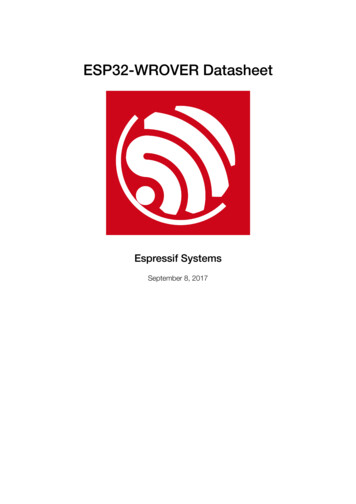
Transcription
ESP32-WROVER DatasheetEspressif SystemsSeptember 8, 2017
About This GuideThis document provides the specifications for the ESP32-WROVER module.The document structure is as follows:ChapterTitleSubjectChapter 1PrefaceAn overview of ESP32-WROVERChapter 2Pin DefinitionsDevice pinout and pin descriptionsChapter 3Functional DescriptionDescription of major functional modulesChapter 4Peripherals and SensorsDescription of peripherals.Chapter 5Electrical CharacteristicsElectrical characteristics and specifications of ESP32-WROVERChapter 6SchematicsThe schematics of ESP32-WROVERChapter 7Peripheral SchematicsThe peripheral schematics of ESP32-WROVERChapter 8DimensionsThe dimensions of ESP32-WROVERChapter 8Learning ResourcesESP32-related must-read materials and must-have resourcesRelease NotesDateVersionRelease notes2017.08V1.0First releaseUpdated Section 2.1Pin Layout;2017.09V1.1Updated the ESP32-WROVER Schematics and dded a note in Chapter 7;Added Chapter 8 Dimensions.Documentation Change NotificationEspressif provides email notifications to keep customers updated on changes to technical documentation.Please subscribe here.CertificatesDownload certificates for Espressif products from here.Disclaimer and Copyright NoticeInformation in this document, including URL references, is subject to change without notice. THIS DOCUMENT ISPROVIDED AS IS WITH NO WARRANTIES WHATSOEVER, INCLUDING ANY WARRANTY OF MERCHANTABILITY, NON-INFRINGEMENT, FITNESS FOR ANY PARTICULAR PURPOSE, OR ANY WARRANTY OTHERWISEARISING OUT OF ANY PROPOSAL, SPECIFICATION OR SAMPLE.All liability, including liability for infringement of any proprietary rights, relating to use of information in this document is disclaimed. No licenses express or implied, by estoppel or otherwise, to any intellectual property rightsare granted herein. The Wi-Fi Alliance Member logo is a trademark of the Wi-Fi Alliance. The Bluetooth logo is aregistered trademark of Bluetooth SIG.All trade names, trademarks and registered trademarks mentioned in this document are property of their respectiveowners, and are hereby acknowledged.Copyright 2017 Espressif Inc. All rights reserved.
Contents1 Overview12 Pin Definitions32.1Pin Layout32.2Pin Description42.3Strapping Pins53 Functional Description73.1CPU and Internal Memory73.2External Flash and SRAM73.3Crystal Oscillators73.4RTC and Low-Power Management84 Peripherals and Sensors104.110Peripherals and Sensors Description5 Electrical Characteristics155.1Absolute Maximum Ratings155.2Wi-Fi Radio155.3BLE Radio165.45.3.1 Receiver165.3.2 Transmitter16Reflow Profile176 Schematics187 Peripheral Schematics198 Dimensions209 Learning Resources219.1Must-Read Documents219.2Must-Have Resources21
List of Tables1ESP32-WROVER Specifications12Pin Definitions43Strapping Pins54Functionalities Depending on the Power Modes85Power Consumption by Power Modes86Description of Peripherals and Sensors107Absolute Maximum Ratings158Wi-Fi Radio Characteristics159Receiver Characteristics — BLE1610Transmitter Characteristics — BLE16
List of Figures1ESP32-WROVER Pin Layout32Reflow Profile173ESP32-WROVER Schematics184ESP32-WROVER Peripheral Schematics195ESP32-WROVER Dimensions20
1. OVERVIEW1. OverviewESP32-WROVER is a powerful, generic WiFi-BT-BLE MCU module that targets a wide variety of applications,ranging from low-power sensor networks to the most demanding tasks, such as voice encoding, music streamingand MP3 decoding.At the core of this module is the ESP32-D0WDQ6 chip*, same as ESP-WROOM-32 module. Compared to ESPWROOM-32, ESP32-WROVER has an additional SPI Pseudo static RAM (PSRAM) of 32 Mbits. As such, ESP32WROVER features both 4 MB external SPI flash and 4 MB external PSRAM.The ESP32-WROVER module has a PCB antenna, while the ESP32-WROVER-I uses an IPEX antenna. Theinformation in this datasheet is applicable to both of the two modules.The chip embedded is designed to be scalable and adaptive. There are two CPU cores that can be individuallycontrolled, and the clock frequency is adjustable from 80 MHz to 240 MHz. The user may also power off theCPU and make use of the low-power co-processor to constantly monitor the peripherals for changes or crossingof thresholds. ESP32 integrates a rich set of peripherals, ranging from capacitive touch sensors, Hall sensors,low-noise sense amplifiers, SD card interface, Ethernet, high-speed SPI, UART, I2S and I2C.Note:* For details on the part number of the ESP32 series, please refer to the document ESP32 Datasheet.The integration of Bluetooth, Bluetooth LE and Wi-Fi ensures that a wide range of applications can be targeted,and that the module is future proof: using Wi-Fi allows a large physical range and direct connection to the internetthrough a Wi-Fi router, while using Bluetooth allows the user to conveniently connect to the phone or broadcastlow energy beacons for its detection. The sleep current of the ESP32 chip is less than 5 µA, making it suitablefor battery powered and wearable electronics applications. ESP32 supports a data rate of up to 150 Mbps,and 20.5 dBm output power at the antenna to ensure the widest physical range. As such the chip does offerindustry-leading specifications and the best performance for electronic integration, range, power consumption,and connectivity.The operating system chosen for ESP32 is freeRTOS with LwIP; TLS 1.2 with hardware acceleration is built in aswell. Secure (encrypted) over the air (OTA) upgrade is also supported, so that developers can continually upgradetheir products even after their release.Table 1 provides the specifications of ESP32-WROVER.Table 1: ESP32-WROVER SpecificationsCategoriesItemsSpecificationsRF certificationFCC/CE-RED/SRRC802.11 b/g/n/e/i (802.11n up to 150 Mbps)Wi-FiProtocolsA-MPDU and A-MSDU aggregation and 0.4 µs guard interval supportFrequency rangeEspressif Systems2.4 GHz 2.5 GHz1ESP32-WROVER Datasheet V1.1
1. tooth v4.2 BR/EDR and BLE specificationNZIF receiver with -97 dBm sensitivityBluetoothRadioClass-1, class-2 and class-3 transmitterAFHAudioCVSD and SBCSD card, UART, SPI, SDIO, I2C, LED PWM, Motor PWM,Module interfaceI2S, IRGPIO, capacitive touch sensor, ADC, DAC, LNA preamplierHardwareOn-chip sensorHall sensor, temperature sensorOn-board clock40 MHz crystalOperating voltage/Power supply2.3 3.6VOperating currentAverage: 80 mAMinimum current delivered bypower supplySoftwareOperating temperature range-40 C 85 CAmbient temperature rangeNormal temperaturePackage size18 0.2 mm x 31.4 0.2 mm x 3.3 0.15 mmWi-Fi modeStation/SoftAP/SoftAP ryptionAES/RSA/ECC/SHAFirmware upgradeSoftware developmentEspressif Systems500 mAUART Download / OTA (via network) / download and writefirmware via hostSupports Cloud Server Development / SDK for customfirmware developmentNetwork protocolsIPv4, IPv6, SSL, TCP/UDP/HTTP/FTP/MQTTUser configurationAT instruction set, cloud server, Android/iOS app2ESP32-WROVER Datasheet V1.1
2. PIN DEFINITIONS2. Pin Definitions2.1 Pin LayoutKeepout Zone1GNDGND382VDD33IO23373ENIO22364SENSOR VPTXD0355SENSOR CLK2039:GNDFigure 1: ESP32-WROVER Pin LayoutEspressif Systems3ESP32-WROVER Datasheet V1.1
2. PIN DEFINITIONS2.2 Pin DescriptionESP32-WROVER has 38 pins. See pin definitions in Table 2.Table 2: Pin r supply.EN3IChip-enable signal. Active high.SENSOR VP4IGPIO36, SENSOR VP, ADC H, ADC1 CH0, RTC GPIO0SENSOR VN5IGPIO39, SENSOR VN, ADC1 CH3, ADC H, RTC GPIO3IO346IGPIO34, ADC1 CH6, RTC GPIO4IO357IGPIO35, ADC1 CH7, RTC GPIO5IO328I/OIO339I/OIO2510I/OGPIO25, DAC 1, ADC2 CH8, RTC GPIO6, EMAC RXD0IO2611I/OGPIO26, DAC 2, ADC2 CH9, RTC GPIO7, EMAC RXD1IO2712I/OGPIO27, ADC2 CH7, TOUCH7, RTC GPIO17, EMAC RX IO9, SD DATA2, SPIHD, HS1 DATA2, U1RXDSWP/SD3*18I/OGPIO10, SD DATA3, SPIWP, HS1 DATA3, U1TXDSCS/CMD*19I/OGPIO11, SD CMD, SPICS0, HS1 CMD, U1RTSSCK/CLK*20I/OGPIO6, SD CLK, SPICLK, HS1 CLK, U1CTSSDO/SD0*21I/OGPIO7, SD DATA0, SPIQ, HS1 DATA0, U2RTSSDI/SD1*22I/OGPIO8, SD DATA1, SPID, HS1 DATA1, O16, HS1 DATA4, U2RXD, EMAC CLK OUTIO1728I/OGPIO17, HS1 DATA5, U2TXD, EMAC CLK OUT 180IO529I/OGPIO5, VSPICS0, HS1 DATA6, EMAC RX CLKIO1830I/OGPIO18, VSPICLK, HS1 DATA7IO1931I/OGPIO19, VSPIQ, U0CTS, EMAC TXD0Espressif SystemsGPIO32, XTAL 32K P (32.768 kHz crystal oscillator input), ADC1 CH4,TOUCH9, RTC GPIO9GPIO33, XTAL 32K N (32.768 kHz crystal oscillator output), ADC1 CH5,TOUCH8, RTC GPIO8GPIO14, ADC2 CH6, TOUCH6, RTC GPIO16, MTMS, HSPICLK,HS2 CLK, SD CLK, EMAC TXD2GPIO12,ADC2 CH5,TOUCH5,RTC GPIO15,MTDI,HSPIQ,HS2 DATA2, SD DATA2, EMAC TXD3GroundGPIO13,ADC2 CH4,TOUCH4,RTC GPIO14,MTCK, HSPID,HS2 DATA3, SD DATA3, EMAC RX ERGPIO15, ADC2 CH3, TOUCH3, MTDO, HSPICS0, RTC GPIO13,HS2 CMD, SD CMD, EMAC RXD3GPIO2, ADC2 CH2, TOUCH2, RTC GPIO12, HSPIWP, HS2 DATA0,SD DATA0GPIO0,ADC2 CH1,TOUCH1,RTC GPIO11,CLK OUT1,EMAC TX CLKGPIO4, ADC2 CH0, TOUCH0, RTC GPIO10, HSPIHD, HS2 DATA1,SD DATA1, EMAC TX ER4ESP32-WROVER Datasheet V1.1
2. PIN 1, VSPIHD, EMAC TX ENRXD034I/OGPIO3, U0RXD, CLK OUT2TXD035I/OGPIO1, U0TXD, CLK OUT3, EMAC RXD2IO2236I/OGPIO22, VSPIWP, U0RTS, EMAC TXD1IO2337I/OGPIO23, VSPID, HS1 STROBEGND38PGround2.3 Strapping PinsPlease refer to Chapter 6 ESP32-WROVER schematics. ESP32 has five strapping pins, which can be seen inSection 6 Schematics: MTDI GPIO0 GPIO2 MTDO GPIO5Software can read the value of these five bits from the register ”GPIO STRAPPING”.During the chip power-on reset, the latches of the strapping pins sample the voltage level as strapping bits of ”0”or ”1”, and hold these bits until the chip is powered down or shut down. The strapping bits configure the deviceboot mode, the operating voltage of VDD SDIO and other system initial settings.Each strapping pin is connected with its internal pull-up/pull-down during the chip reset. Consequently, if a strapping pin is unconnected or the connected external circuit is high-impendence, the internal weak pull-up/pull-downwill determine the default input level of the strapping pins.To change the strapping bit values, users can apply the external pull-down/pull-up resistances, or apply the hostMCU’s GPIOs to control the voltage level of these pins when powering on ESP32.After reset, the strapping pins work as the normal functions pins.Refer to Table 3 for detailed boot modes’ configuration by strapping pins.Table 3: Strapping PinsVoltage of Internal LDO (VDD SDIO)PinDefaultMTDIPull-down3.3V1.8V01Booting ModePinDefaultSPI BootDownload ging Log on U0TXD During BootingPinDefaultU0TXD TogglingU0TXD SilentMTDOPull-up10Espressif Systems5ESP32-WROVER Datasheet V1.1
2. PIN DEFINITIONSTiming of SDIO ge OutputRising-edge OutputFalling-edge OutputRising-edge OutputPull-up0011Pull-up0101Note: Firmware can configure register bits to change the settings of ”Voltage of Internal LDO (VDD SDIO)” and ”Timingof SDIO Slave” after booting. The MTDI is internally pulled high in the module, as the flash and SRAM in ESP32-WROVER only support a powervoltage of 1.8V (output by VDD SDIO).Espressif Systems6ESP32-WROVER Datasheet V1.1
3. FUNCTIONAL DESCRIPTION3. Functional DescriptionThis chapter describes the modules and functions integrated in ESP32-WROVER.3.1 CPU and Internal MemoryESP32-D0WDQ6 contains two low-power Xtensa 32-bit LX6 microprocessors. The internal memory includes: 448 KB of ROM for booting and core functions. 520 KB (8 KB RTC FAST Memory included) of on-chip SRAM for data and instruction.– 8 KB of SRAM in RTC, which is called RTC FAST Memory and can be used for data storage; it isaccessed by the main CPU during RTC Boot from the Deep-sleep mode. 8 KB of SRAM in RTC, which is called RTC SLOW Memory and can be accessed by the co-processor duringthe Deep-sleep mode. 1 kbit of eFuse, of which 256 bits are used for the system (MAC address and chip configuration) and theremaining 768 bits are reserved for customer applications, including Flash-Encryption and Chip-ID.3.2 External Flash and SRAMESP32 supports up to four 16-MB of external QSPI flash and SRAM with hardware encryption based on AES toprotect developers’ programs and data.ESP32 can access the external QSPI flash and SRAM through high-speed caches. Up to 16 MB of external flash are memory-mapped onto the CPU code space, supporting 8, 16 and 32-bitaccess. Code execution is supported. Up to 8 MB of external flash/SRAM are memory-mapped onto the CPU data space, supporting 8, 16 and32-bit access. Data-read is supported on the flash and SRAM. Data-write is supported on the SRAM.ESP32-WROVER integrates 4 MB of external SPI flash. The 4-MB SPI flash can be memory-mapped onto theCPU code space, supporting 8, 16 and 32-bit access. Code execution is supported.In addition to the 4 MB SPI flash, ESP32-WROVER also integrates 4 MB PSRAM for more memory space.3.3 Crystal OscillatorsThe ESP32 Wi-Fi/BT firmware can only support 40 MHz crystal oscillator for now.Espressif Systems7ESP32-WROVER Datasheet V1.1
3. FUNCTIONAL DESCRIPTION3.4 RTC and Low-Power ManagementWith the use of advanced power management technologies, ESP32 can switch between different power modes(see Table 4). Power modes– Active mode: The chip radio is powered on. The chip can receive, transmit, or listen.– Modem-sleep mode: The CPU is operational and the clock is configurable. The Wi-Fi/Bluetooth baseband and radio are disabled.– Light-sleep mode: The CPU is paused. The RTC memory and RTC peripherals, as well as the ULPco-processor are running. Any wake-up events (MAC, host, RTC timer, or external interrupts) will wakeup the chip.– Deep-sleep mode: Only the RTC memory and RTC peripherals are powered on. Wi-Fi and Bluetoothconnection data are stored in the RTC memory. The ULP co-processor can work.– Hibernation mode: The internal 8-MHz oscillator and ULP co-processor are disabled. The RTC recoverymemory is powered down. Only one RTC timer on the slow clock and some RTC GPIOs are active.The RTC timer or the RTC GPIOs can wake up the chip from the Hibernation mode. Sleep Patterns– Association sleep pattern: The power mode switches between the Active mode, Modem- and Lightsleep mode during this sleep pattern. The CPU, Wi-Fi, Bluetooth, and radio are woken up at predetermined intervals to keep Wi-Fi/BT connections alive.– ULP sensor-monitored pattern: The main CPU is in the Deep-sleep mode. The ULP co-processor takessensor measurements and wakes up the main system, based on the data collected from sensors.Table 4: Functionalities Depending on the Power ModesPower modeActiveModem-sleepLight-sleepAssociation sleep patternSleep patternDeep-sleepULPsensor-monitored patternHibernation-CPUONONPAUSEOFFOFFWi-Fi/BT baseband and radioONOFFOFFOFFOFFONONONONOFFONONONON/OFFOFFRTC memory and RTC peripheralsULP co-processorThe power consumption varies with different power modes/sleep patterns and work statuses of functional modules.Please see Table 5 for details.Table 5: Power Consumption by Power ModesPower modeDescriptionPower consumptionWi-Fi Tx packet 14 dBm 19.5 dBmActive (RF working)Wi-Fi / BT Tx packet 0 dBmPlease refer to ESP32 Datasheet.Wi-Fi / BT Rx and listeningAssociation sleep pattern (by Light-sleep)Espressif Systems81 mA 4 mA @DTIM3ESP32-WROVER Datasheet V1.1
3. FUNCTIONAL DESCRIPTIONPower modeDescriptionPower consumptionMax speed 240 MHz: 30 mA 50 mAModem-sleepNormal speed 80 MHz: 20 mA 25 mAThe CPU is powered on.Slow speed 2 MHz: 2 mA 4 mALight-sleep-0.8 mAThe ULP co-processor is powered on.150 µAULP sensor-monitored pattern100 µA @1% dutyRTC timer RTC memory10 µAHibernationRTC timer only5 µAPower offCHIP PU is set to low level, the chip is powered off0.1 µADeep-sleepNote: During Deep-sleep, when the ULP co-processor is powered on, peripherals such as GPIO and I2C are able towork. When the system works in the ULP sensor-monitored pattern, the ULP co-processor works with the ULP sensorperiodically; ADC works with a duty cycle of 1%, so the power consumption is 100 µA.Espressif Systems9ESP32-WROVER Datasheet V1.1
4. PERIPHERALS AND SENSORS4. Peripherals and Sensors4.1 Peripherals and Sensors DescriptionTable 6: Description of Peripherals and SensorsInterfaceSignalPinADC1 CH0SENSOR VPADC1 CH3SENSOR VNADC1 CH4IO32ADC1 CH5IO33ADC1 CH6IO34ADC1 CH7IO35ADC2 CH0IO4ADC2 CH1IO0ADC2 CH2IO2ADC2 CH3IO15ADC2 CH4IO13ADC2 CH5IO12ADC2 CH6IO14ADC2 CH7IO27ADC2 CH8IO25ADC2 CH9IO26Ultra-Low NoiseSENSOR VPIO36Provides about 60 dB gain by using largerAnalog Pre-AmplifierSENSOR VNIO39capacitors on PCBDAC 1IO25DAC 32HS2 CLKMTMSADCDACTouch SensorHS2 CMDMTDOSD/SDIO/MMC HostHS2 DATA0IO2ControllerHS2 DATA1IO4HS2 DATA2MTDIHS2 DATA3MTCKEspressif Systems10FunctionTwo 12-bit SAR ADCsTwo 8-bit DACsCapacitive touch sensorsSupports SD memory card V3.01 standardESP32-WROVER Datasheet V1.1
4. PERIPHERALS AND SENSORSInterfaceSignalPinFunctionPWM0 OUT0 2PWM1 OUT IN0 2Three channels of 16-bit timers generatePWM0 FLT IN0 2Motor PWMPWM1 FLT IN0 2PWM waveforms. Each channel has a pairAny GPIOs*of output signals, three fault detectionPWM0 CAP IN0 2signals, three event-capture signals, andPWM1 CAP IN0 2three sync signals.PWM0 SYNC IN0 2PWM1 SYNC IN0 2LED PWMledc hs sig out0 7ledc ls sig out0 7Any GPIOs*16 independent channels @80 MHzclock/RTC CLK. Duty accuracy: 16 bits.U0RXD inU0CTS inU0DSR inU0TXD outU0RTS outU0DTR outUARTU1RXD inAny GPIOs*U1CTS inTwo UART devices with hardwareflow-control and DMAU1TXD outU1RTS outU2RXD inU2CTS inU2TXD outU2RTS outI2CEXT0 SCL inI2CEXT0 SDA inI2CEXT1 SCL inI2CI2CEXT1 SDA inAny GPIOs*Two I2C devices in slave or master modesI2CEXT0 SCL outI2CEXT0 SDA outI2CEXT1 SCL outI2CEXT1 SDA outEspressif Systems11ESP32-WROVER Datasheet V1.1
4. PERIPHERALS AND SENSORSInterfaceSignalPinFunctionI2S0I DATA in0 15I2S0O BCK inI2S0O WS inI2S0I BCK inI2S0I WS inI2S0I H SYNCI2S0I V SYNCI2S0I H ENABLEI2S0O BCK outI2S0O WS outI2S0I BCK outI2S0I WS outI2SI2S0O DATA out0 23Any GPIOs*I2S1I DATA in0 15Stereo input and output from/to the audiocodec, and parallel LCD data outputI2S1O BCK inI2S1O WS inI2S1I BCK inI2S1I WS inI2S1I H SYNCI2S1I V SYNCI2S1I H ENABLEI2S1O BCK outI2S1O WS outI2S1I BCK outI2S1I WS outI2S1O DATA out0 23Remote ControllerEspressif SystemsRMT SIG IN0 7RMT SIG OUT0 7Any GPIOs*12Eight channels of IR transmitter andreceiver for various waveformsESP32-WROVER Datasheet V1.1
4. PERIPHERALS AND SENSORSInterfaceParallel CS0IO15Supports Standard SPI, Dual SPI, andHSPIQIO12Quad SPI that can be connected to theHSPIDIO13external flash and 19VSPIDIO23VSPIHDIO21VSPIWPIO22HSPIQ in/ outStandard SPI consists of clock,HSPID in/ outchip-select, MOSI and MISO. These SPIsHSPICLK in/ outcan be connected to LCD and otherHSPI CS0 in/ outexternal devices. They support theHSPI CS1 outfollowing features:General PurposeHSPI CS2 outSPIVSPIQ in/ outAny GPIOs* 4 sub-modes of the SPI formattransfer that depend on the clockVSPICLK in/ outphase (CPHA) and clock polarity(CPOL) control; configurable SPI frequency;VSPI CS1 out up to 64 bytes of FIFO and DMA.VSPI CS2 outEspressif Systems both master and slave modes;VSPID in/ outVSPI CS0 in/ TAG for software debuggingESP32-WROVER Datasheet V1.1
4. PERIPHERALS AND SENSORSInterfaceSDIO SlaveEMACSignalPinSD CLKIO6SD CMDIO11SD DATA0IO7SD DATA1IO8SD DATA2IO9SD DATA3IO10EMAC TX CLKIO0EMAC RX CLKIO5EMAC TX ENIO21EMAC TXD0IO19EMAC TXD1IO22EMAC TXD2IO14EMAC TXD3IO12EMAC RX ERIO13EMAC RX DVIO27EMAC RXD0IO25EMAC RXD1IO26EMAC RXD2TXD0EMAC RXD3IO15EMAC CLK OUTIO16EMAC CLK OUT 180IO17EMAC TX ERIO4EMAC MDC outAny GPIOs*EMAC MDI inAny GPIOs*EMAC MDO outAny GPIOs*EMAC CRS outAny GPIOs*EMAC COL outAny GPIOs*FunctionSDIO interface that conforms to theindustry standard SDIO 2.0 cardspecification.Ethernet MAC with MII/RMII interfaceNote:Functions of Motor PWM, LED PWM, UART, I2C, I2S, general purpose SPI and Remote Controller can be configured toany GPIO.Espressif Systems14ESP32-WROVER Datasheet V1.1
5. ELECTRICAL CHARACTERISTICS5. Electrical CharacteristicsNote:The specifications in this chapter have been tested under the following general condition: VDD 3.3V, TA 27 C, unlessotherwise specified.5.1 Absolute Maximum RatingsTable 7: Absolute Maximum RatingsParameterSymbolMinTypMaxUnitPower supplyVDD2.33.33.6VIV DD0.5--AVIL-0.3-0.25 VIO 1Minimum current delivered bypower supplyInput low voltageInput high voltageVIH0.75 VIOInput leakage currentIILInput pin capacitanceCpadOutput low voltageVOL11V-VIO 0.3V--50nA--21pF1-0.1 VIOV--VOutput high voltageVOH0.8 VIOMaximum output drive capabilityIM AX--40mAStorage temperature rangeTST R-40-85 COperating temperature rangeTOP R-40-85 C1. VIO is the power supply for a specific pad. More details can be found in the ESP32 Datasheet, Appendix IO MUX. Forexample, the power supply for SD CLK is the VDD SDIO.5.2 Wi-Fi RadioTable 8: Wi-Fi Radio CharacteristicsDescriptionMinTypicalMaxUnitInput frequency2412-2484MHzOutput impedance-30 j10-ΩInput reflection---10dBTx powerOutput power of PA for 72.2 Mbps131415dBmOutput power of PA for 11b mode19.52020.5dBmSensitivityDSSS, 1 Mbps--98-dBmCCK, 11 Mbps--91-dBmOFDM, 6 Mbps--93-dBmOFDM, 54 Mbps--75-dBmHT20, MCS0--93-dBmEspressif Systems15ESP32-WROVER Datasheet V1.1
5. ELECTRICAL CHARACTERISTICSDescriptionMinTypicalMaxUnitHT20, MCS7--73-dBmHT40, MCS0--90-dBmHT40, MCS7--70-dBmMCS32--89-dBmAdjacent channel rejectionOFDM, 6 Mbps-37-dBOFDM, 54 Mbps-21-dBHT20, MCS0-37-dBHT20, MCS7-20-dB5.3 BLE Radio5.3.1 ReceiverTable 9: Receiver Characteristics — BLEParameterConditionsMinTypMaxUnitSensitivity @30.8% PER---97-dBmMaximum received signal @30.8% PER-0--dBmCo-channel C/I-- 10-dBF F0 1 MHz--5-dBF F0 - 1 MHz--5-dBF F0 2 MHz--25-dBF F0 - 2 MHz--35-dBF F0 3 MHz--25-dBF F0 - 3 MHz--45-dB30 MHz 2000 MHz-10--dBm2000 MHz 2400 MHz-27--dBm2500 MHz 3000 MHz-27--dBm3000 MHz 12.5 GHz-10--dBm--36--dBmAdjacent channel selectivity C/IOut-of-band blocking performanceIntermodulation5.3.2 TransmitterTable 10: Transmitter Characteristics — BLEParameterConditionsMinTypMaxUnitRF transmit power--0-dBmGain control step-- 3-dBmRF power control range--12- 12dBmEspressif Systems16ESP32-WROVER Datasheet V1.1
5. ELECTRICAL CHARACTERISTICSParameterConditionsMinTypMaxUnitF F0 1 MHz--14.6-dBmF F0 - 1 MHz--12.7-dBmF F0 2 MHz--44.3-dBmF F0 - 2 MHz--38.7-dBmF F0 3 MHz--49.2-dBmF F0 - 3 MHz--44.7-dBmF F0 3 MHz--50-dBmF F0 - 3 MHz--50-dBm f 1avg---265kHz f 2max-247--kHz f 2avg / f 1avg---0.92--ICFT---10-kHzDrift rate--0.7-kHz/50 µsDrift--2-kHzAdjacent channel transmit powerTemperature ( )5.4 Reflow ProfilePeak Temp.235 250 250Preheating zone150 200 60 120s217200Cooling down zone3 5 /sSoldering time 30sRamp-up zone1 3 /s1005025Time (sec.)0050100150200250Ramp-up zone — Temp.: 150 Time: 60 90s Ramp-up rate: 1 3 /sPreheating zone — Temp.: 150 200 Time: 60 120s Ramp-up rate: 0.3 0.8 /sReflow soldering zone — Peak Temp.: 235 250 ( 245 recommended) Time: 30 70sCooling down zone — Temp.: 217 170 Ramp-down rate: 3 5 /sSolder — Sn&Ag&Cu Lead-free solder (SAC305)Figure 2: Reflow ProfileEspressif Systems17ESP32-WROVER Datasheet V1.1
6. SCHEMATICSESP32 Module:with 1.8V Flash & SRAMThe operating voltage for signals marked in blue is DGND XOUTXINC1VDD33U1GNDGND3GND4Espressif Systems6. 0RXDGPIO22GPIO19C6C5VDD33VDD33R1 20K(1%)GNDC9C40.1uF/6.3V(10%)GND40MHz 6.3V(10%)1210uF/16V(10%) 10uF/16V(10%) 1uF/16V(10%) 0.1uF/6.3V(10%)R140(1%)/NCGNDGNDGNDGNDGNDR15 0(1%)C14C15PCB ANT2.4pF/50V( 0.25pF)181234L4C16SENSOR VP 562.7nH( 0.1nH)270pF/6.3V(10%)7SENSOR VN 8C17CHIP PU910270pF/6.3V(10%) 443424140393837C10VDDALNA INVDD3P3VDD3P3SENSOR VPSENSOR CAPPSENSOR CAPNSENSOR VNCHIP PUVDET 1VDET 232K XPGPIO33SCK/CLKR120(1%)Pin.3CHIP PU/ENPin.17SD2Pin.4SENSOR VPPin.18SD3Pin.5SENSOR P/SD3SHD/SD2GPIO17GPIO16FLASH F/6.3V(10%)FLASH DPin.34RXD0SCS/CMDPin.7IO35VDD SD DATA 1SD DATA 0SD CLKSD CMDSD DATA 3SD DATA 2GPIO17VDD SDIOGPIO16GNDGPIO23Pin.36IO22SHD/SD2SENSOR VNCAP1CAP2VDDAXTAL PXTAL NVDDAGPIO21U0TXDU0RXDGPIO22GPIO19VDD3P3 CPUC1132K XNGPIO25GPIO26GPIO27MTMSMTDIVDD3P3 SOR -CCHIP 11IO26GPIO26GNDSRAM PIO14GPIO4R9Pin.14IO12GPIO12VDD SDIOVDD SDIOSHD/SD27VCC1FLASH CLK 6/CSCLK/HOLDFLASHGNDSCS/CMD8VDD SDIOU34ESP32-WROVER Datasheet SSSI/SIO08765SHD/SD2SRAM CLKSDI/SD1PN18S32GNDGNDFigure 3: ESP32-WROVER Schematics10K(1%)Pin.39GNDPin.25IO0GNDGPIO0
7. PERIPHERAL SCHEMATICS7. Peripheral 0K(5%)C30.1uF/50V(10%)C1GNDP LKESP32 WROVERReset ButtonGNDJP2Boot OptionJP3SW1R2C41234UART12R1GND13V3ENSENSOR VPSENSOR D3CMD12123ENGPI36 SENSOR VP 4GPI39 SENSOR VN 15MTMSMTDIMTCKMTDOJTAGGNDFigure 4: ESP32-WROVER Peripheral SchematicsNote:It is recommended that users do not solder Pad 39 to the base board.Espressif Systems19ESP32-WROVER Datasheet V1.1
8. DIMENSIONS8. Dimensions唀渀洀愀爀欀攀搀Figure 5: ESP32-WROVER DimensionsEspressif Systems20ESP32-WROVER Datasheet V1.1
9. LEARNING RESOURCES9. Learning Resources9.1 Must-Read DocumentsThe following link provides documents related to ESP32. ESP32 DatasheetThis document provides an introduction to the specifications of the ESP32 hardware, including overview, pindefinitions, functional description, peripheral interface, electrical characteristics, etc. ESP32 Technical Reference ManualThe manual provides detailed information on how to use the ESP32 memory and peripherals. ESP32 Hardware ResourcesThe zip files include the schematics, PCB layout, Gerber and BOM list of ESP32 modules and developmentboards. ESP32 Hardware Design GuidelinesThe guidelines outline recommended design practices when developing standalone or add-on systemsbased on the ESP32 series of products, including ESP32, the ESP-WROOM-32 module, and ESP32DevKitC—the development board. ESP32 AT Instruction Set and ExamplesThis document introduces the ESP32 AT commands, explains how to use them, and provides examples ofseveral common AT commands.9.2 Must-Have ResourcesHere are the ESP32-related must-have resources. ESP32 BBSThis is an Engineer-to-Engineer (E2E) Community for ESP32 where you can post questions, share knowledge,explore ideas, and help solve problems with fellow engineers. ESP32 GithubESP32 development projects are freely distributed under Espressif’s MIT license on Github. It is establishedto help developers get started with ESP32 and foster innovation and the growth of general knowledge aboutthe hardware and software surrounding ESP32 devices. ESP32 ToolsThis is a webpage where users can download ESP32 Flash Download Tools and the zip file ”ESP32 Certification and Test”. ESP32 IDFThis webpage links users to the official IoT development framework for ESP32. ESP32 ResourcesThis webpage provides the links to all available ESP32 documents, SDK and tools. Espressif Systems21ESP32-WROVER Datasheet V1.1
MCU's GPIOs to control the voltage level of these pins when powering on ESP32. After reset, the strapping pins work as the normal functions pins. Refer to Table 3 for detailed boot modes' configuration by strapping pins. Table 3: Strapping Pins Voltage of Internal LDO (VDD_SDIO) Pin Default 3.3V 1.8V
